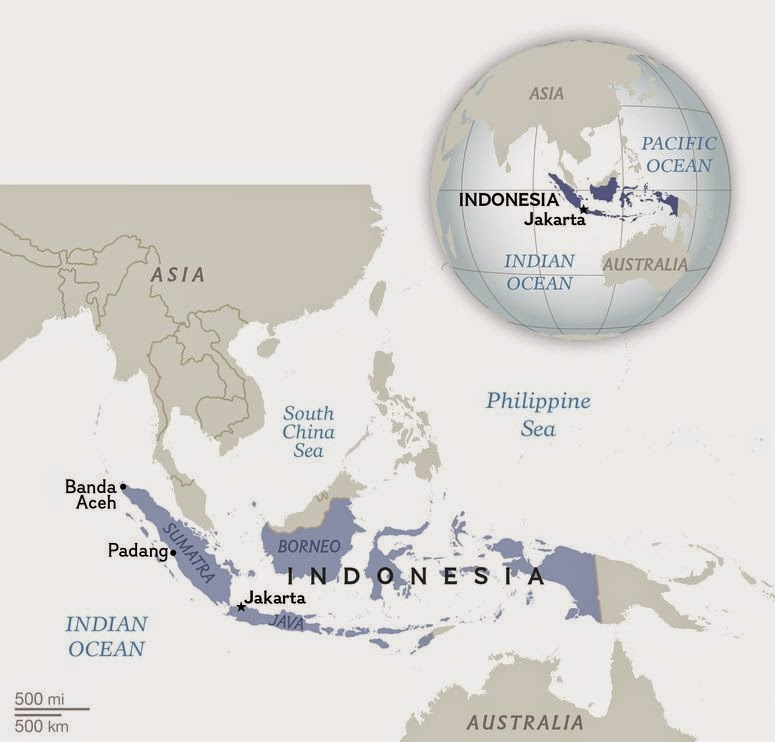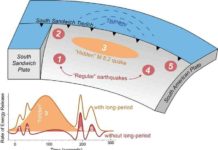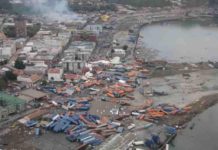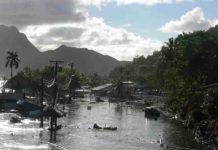
Ten years ago, one of the deadliest natural disasters in history killed 227,898 people in 14 countries around the Indian Ocean—nearly 170,000 of them in Indonesia.It began on the morning of December 26, 2004, about 150 miles (240 kilometers) off the west coast of Sumatra, when a magnitude 9.1 earthquake—the third largest since 1900—ruptured the ocean floor. Within eight minutes the fracture spanned 700 miles (1,127 kilometers), releasing 23,000 times more energy than the atomic bomb that destroyed Nagasaki, Japan. Parts of the seabed shifted 30 feet (9 meters) to the west-southwest.
But that was not the worst of it. Some segments of the fault also surged upward by tens of feet, and they lifted the whole column of seawater above them. At the sea surface, that set in motion a wave—a tsunami that traveled around the Indian Ocean. When it hit Sumatra, it was 100 feet (30 meters) high along parts of the northwest coast.
It was the tsunami that did the killing.
When the next tsunami strikes the Indian Ocean—and scientists are certain that another large one is inevitable, probably within the next few decades—will the region fare any better?
Looking Back
Hardest hit on that terrible day ten years ago was the Indonesian city of Banda Aceh, on Sumatra’s northern tip. More than 60,000 of its 264,000 residents perished—about 35 percent of the total lost in Indonesia. (Read more about the Indonesian and Japanese tsunamis.)
Vivi Yanti, an English teacher in the city, remembers the water as being warm, black, oily, and filled with debris. In streets jammed with fleeing people, Yanti glimpsed a woman running, holding the hand of a little boy, banging on the windows of passing cars, begging for a ride. No one stopped. “I escaped by riding with my uncle on the back of his motorcycle,” says Yanti. “I remember looking back, and at first I didn’t know what I was seeing—the water was carrying a big ship down the street. I told my uncle, ‘Drive faster.'”
Ten years later Banda Aceh has been rebuilt, and its population has climbed back to 250,000, almost what it was before the disaster. With smooth new highways and vibrant late-night cafés, the city has been transformed. Aside from a number of immaculately groomed mass graves, and a few intentional reminders of the disaster—such as the presence of a large ship marooned in a city park—most signs of the tsunami’s damage have been erased.
Like other countries ravaged by the 2004 tsunami, Indonesia is now linked to a tsunami detection system in the Indian Ocean. Once an earthquake has occurred, that system of seafloor sensors and surface buoys relays signals via satellite to government warning centers around the world, alerting them that a tsunami might be on the way.

A decade ago such detectors existed only in the Pacific. Had they been deployed in the Indian Ocean in 2004, some of the 51,000 people who died in Sri Lanka and India would have been spared: The tsunami took two hours to cross the Indian Ocean, and timely warnings—or any warning at all—would have saved thousands of lives.
But Indonesia—the fourth most populous country in the world—is in a less fortunate situation. It borders a number of dangerous seismic faults, especially a long, arcing one called the Sunda megathrust, which parallels the islands of Sumatra and Java. The 2004 tsunami that began on that fault struck the Sumatran coast within 30 minutes of the earthquake. Even with a near instantaneous tsunami alert, many residents wouldn’t have had enough time to reach high ground.
Faced with such an unforgiving margin between life and death, Indonesia has struggled to improve public awareness and preparedness. A handful of evacuation shelters—three- or four-story buildings, some of them with open ground floors to let the wave pass through—have been built in Banda Aceh and other threatened cities. There’s a network of sirens to warn residents that a tsunami is imminent.
But much remains to be done, as the response to a recent earthquake made painfully evident.
A Practice Run Goes Badly
On April 11, 2012, when a magnitude 8.6 earthquake struck Banda Aceh, Indonesia’s National Tsunami Warning Center issued a tsunami alert within five minutes of the first tremors. The nation’s early warning system worked perfectly, but the local response to the alert does not bode well for future disasters. Officials in Banda Aceh had failed to establish clear emergency guidelines for the city. Although the earthquake didn’t generate a tsunami—the plates along the fault in this case slipped horizontally, not violently upward—people with horrific firsthand experience expected one, and panicked.
“The conditions were totally chaotic,” says Syarifah Marlina Al Mazhir, a lifelong resident of Banda Aceh who worked for the Red Cross during the 2004 tsunami. “Instead of evacuating to safe areas, people were going home or picking up the kids at school, which created traffic jams.”
Even worse, she says, the staff responsible for operating the tsunami sirens fled, and the city’s three multi-story tsunami shelters were locked.
“In Banda Aceh everything became paralyzed very quickly,” says Tom Alcedo, the head of the American Red Cross in Indonesia. “Roads to high ground got choked. All those people in their cars would have been swept away. It was a wake-up call.”
Ardito Kodijat, the director of the Indian Ocean Tsunami Information Center in Jakarta, says Banda Aceh and other coastal cities in Indonesia need to establish well-marked evacuation routes and conduct regular tsunami drills. Many people in Banda Aceh, he says, didn’t know that evacuation centers had been built. Others, having witnessed the ferocity of the 2004 tsunami, thought the structures would be unsafe, and tried to escape inland instead. “The people could have been much better prepared if there had been clear and strong guidance from the local government,” says Kodijat.
Banda Aceh, though, is probably not the most threatened of Indonesia’s cities. “The shoe dropped there already,” says Brian Atwater, a geologist with the U.S. Geological Survey. “It’s not at all clear how often earthquakes repeat, and whether the fault that broke in 2004 spent everything it had on that earthquake, or whether there’s something left in the bank. In the meantime, you have plenty of other places with poorly understood hazards. Padang is a next-shoe-drop kind of place.”
Geological evidence of past tsunamis suggest that the segment of the Sunda megathrust that lies off Padang, a city of one million on Sumatra’s west coast, may be overdue for an earthquake. Government officials in Indonesia and Padang are aware of the risk. As in Banda Aceh, evacuation routes have been planned and emergency shelters built.
But in Indonesia and other countries along the rim of the Indian Ocean, such measures may be insufficient to protect the hundreds of millions of people who live along the coasts. Even with the best warning systems and evacuation plans, there are simply too many people in harm’s way. In Southeast Asia alone, more than ten million people live within a mile of the coast. Short of moving Banda Aceh, Padang, and every other threatened coastal city miles inland, there’s no fail-safe defense against future tsunamis.
Kerry Sieh, a geologist at Nanyang Technological University’s Earth Observatory in Singapore, has spent more than 20 years studying the faults around Sumatra. Geologists like Sieh can tell us when earthquakes have occurred in the past, and when and where they’re likely to occur in the future. While they can’t tell us exactly when to run, they can say with certainty that many of us are living in dangerous places.
Given the sheer numbers of lives at risk, Sieh says, there is only so much governments can do, especially in poor countries like Indonesia, to prevent catastrophic losses from the inevitable future tsunamis. “Is good work being done?” Sieh asks. “Yes. There are people trying to educate; there are people trying to build vertical evacuation structures. But will it solve even 10 percent of the problem? I have my doubts.”
Note : The above story is based on materials provided by National Geographic. The original article was written by Tim Folger.










